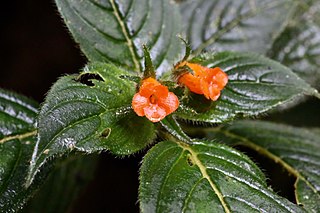
Mackerel is a common name applied to a number of different species of pelagic fish, mostly from the family Scombridae. They are found in both temperate and tropical seas, mostly living along the coast or offshore in the oceanic environment.

The green hermit is a large hummingbird that is a resident breeder from southern Central America south to northern South America

Litoria is a genus of Pelodryadidae tree frogs native to Australia, the Bismarck Archipelago, the Solomon Islands, New Guinea, the Lesser Sunda Islands, and the Moluccan Islands. It is the only genus in the monotypic subfamily Litoriinae and are sometimes collectively referred to as Australasian treefrogs. They are distinguishable from other tree frogs by the presence of horizontal irises, no pigmentation of the eyelids, and their distribution east and south from Wallacea. Over 90 species are described, but several new species are described every year on average, such as the Pinocchio frog, discovered in 2008 and described in 2019.
The least gerbil is distributed mainly in South Sudan, southwestern Ethiopia, Kenya, and Tanzania.
The Agag gerbil is distributed mainly in southern Mauritania to northern Nigeria and Sudan. IUCN lists the junior synonyms Gerbillus cosensi and G. dalloni as critically endangered.

Besleria is a genus of ca. 200 species of large herbs and soft-stemmed subshrubs or shrubs in the flowering plant family Gesneriaceae. They occur in Central America, South America, and the West Indies.

The coppery-headed emerald is a small hummingbird endemic to Costa Rica. It measures a mere 3 in (7.6 cm) in length, and weighs only 3 g (0.11 oz). The male has distinctive coppery crown and rump with a whole green belly and white vent. The female has a white belly and a narrow black subterminal band on white outer rectrices of the tail. Its noticeably decurved bill sets it apart from similar the allopatric white-tailed emerald.

The purple-throated mountaingem is a hummingbird that breeds in the mountains of southern Nicaragua, northern Costa Rica and western Panama. This bird inhabits forested areas in hilly terrain, and is found at altitudes from 800 to 2,500 m.

The Terebridae, commonly referred to as auger shells or auger snails, is a group or family of small to large predatory marine gastropods in the superfamily Conoidea.
Oecomys paricola, also known as the Brazilian oecomys, Brazilian arboreal rice rat, or South Amazonian arboreal rice rat, is a species of rodent in the genus Oecomys of family Cricetidae. It is found in central Brazil south of the Amazon, where it lives in lowland tropical rainforest.

Kemp's gerbil is a species of rodent. Mammal Species of the World considers G. kempi and G. gambianus to be synonyms, however the IUCN has assessed each taxon as were they different species.
The Oruge tree frog is a species of frog in the family Pelodryadidae. It is found in New Guinea. Its natural habitats are subtropical or tropical moist montane forests and rivers.
Besleria miniata is a species of plant in the family Gesneriaceae. It is endemic to Ecuador. Its natural habitat is subtropical or tropical moist lowland forests.
Besleria quadrangulata is a species of plant in the family Gesneriaceae. It is endemic to Ecuador. Its natural habitats are subtropical or tropical moist lowland forests and subtropical or tropical moist montane forests.

Helicia is a genus of 110 species of trees and shrubs, constituting part of the plant family Proteaceae. They grow naturally in rainforests throughout tropical South and Southeast Asia, including India, Sri Lanka, Indochina, Peninsular Malaysia to New Guinea and as far south as New South Wales.

The World's 25 Most Endangered Primates is a list of highly endangered primate species selected and published by the International Union for Conservation of Nature (IUCN) Species Survival Commission (SSC) Primate Specialist Group (PSG), the International Primatological Society (IPS), Global Wildlife Conservation (GWC), and Bristol Zoological Society (BZS). The IUCN/SSC PSG worked with Conservation International (CI) to start the list in 2000, but in 2002, during the 19th Congress of the International Primatological Society, primatologists reviewed and debated the list, resulting in the 2002–2004 revision and the endorsement of the IPS. The publication was a joint project between the three conservation organizations until the 2012–2014 list when BZS was added as a publisher. The 2018–2020 list was the first time Conservation International was not among the publishers, replaced instead by GWC. The list has been revised every two years following the biannual Congress of the IPS. Starting with the 2004–2006 report, the title changed to "Primates in Peril: The World's 25 Most Endangered Primates". That same year, the list began to provide information about each species, including their conservation status and the threats they face in the wild. The species text is written in collaboration with experts from the field, with 60 people contributing to the 2006–2008 report and 85 people contributing to the 2008–2010 report. The 2004–2006 and 2006–2008 reports were published in the IUCN/SSC PSG journal Primate Conservation,, since then they have been published as independent publications.

The Cioccolato di Modica is an Italian P.G.I. specialty chocolate, typical of the municipality of Modica in Sicily, characterized by an ancient and original recipe using manual grinding which gives the chocolate a peculiar grainy texture and aromatic flavor.











